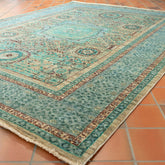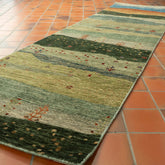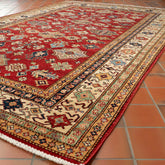Clare Jennings and Kamet Silk rugs
 Bamboo Silk Origins
Bamboo Silk Origins
Bamboo silk has been manufactured for many years, possibly as early as the 1900, but has only recently been produced and introduced to the rug industry. Bamboo silk is natural, being produced from spun cellulose fibre which has been extracted from the pulp of bamboo canes, and has the advantage of being very sustainable.
Is it time for the traditional rug producers to change? Clare Jennings acknowledges that the traditional craft of rug making, which had survived for centuries, does not always meet the needs of the modern home and interiors.
Construction of Kamet Silk Rugs

The woody part of the bamboo is crushed mechanically before a natural enzyme retting and washing process is used to break down the walls and extract the bamboo fibre.
The bamboo silk is produced from spun cellulose fibre which has been extracted from the crushed pulp of bamboo canes. After extraction, the cellulose is then left to dry. Once dried, it is expelled to a become a soft silky fibre. The construction methods of bamboo silk rugs are the same; hand tied knots onto cotton foundations that create unique designs with vibrant and rich colours.
The Ups and downs of our Kamet Silk Rugs

One advantage of bamboo fibre is it's overall sustainability. The bamboo stems are cut, not the whole plant so that the roots can regrow for additional harvesting. The yarn is also highly absorbent allowing dyes to take easily, producing interesting and exciting colours, with a tendency to create some very striking shading effects. To add onto this, bamboo silk is said to be naturally anti-microbial, although the benefits to this are currently open for debate.

As stated earlier, bamboo fibre yarn is very absorbent and hygroscopic, providing stunning shading effects. However, this could be a concern to owners of Kamet silk rugs, due to the absorbent nature of the fibre spillages could be an issue. Swift action is advised in order to prevent spillages from causing damage and discolouration due to the wool and silk having different absorption rates.










 Bamboo Silk Origins
Bamboo Silk Origins
Leave a comment
Please note, comments need to be approved before they are published.